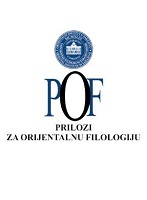Sokollu Mehmed Paşa’nin Şeyhi Nureddinzâde Mustafa Muslîhuddîn’nin Tekkesi Ve Eserleri
The tekke and the work of Nureddinzâde Mustafa Muslîhuddîn, sheikh to Mehmed Pasha Sokolović
Author(s): Mehmet Cemal ÖztürkSubject(s): Cultural history, 16th Century, The Ottoman Empire, Sociology of Religion
Published by: Orijentalni Institut u Sarajevu
Keywords: Nureddinzade; Mehmed Pasha Sokolović; Halveti tariqat; Jamaili branch of the Halveti tariqat; Plovdiv;
Summary/Abstract: Born in 908/1502 in Plovdiv (Filibe). Following formal education, he joined the Halwati-Jamaili sheikh Bali from Sofia, and became his khalif. After spending some time in Pazardžik (Tatarpazarcik) as a preacher (vaiz) and a Sufi teacher (murshid), he moved to Istanbul and spent a number of years as the sheikh of a zawia in the Küçükayasofya mosque complex. His congregation was also attended by Aziz Mahmud Hüdâyî, while was a student and a perfect of the madrasa. There is information that his followers and supporters included numerous prominent individuals such as the Sultan, Suleiman the Lawgiver, and his Grand Vizier Mehmed Pasha Sokolović. Sheikh Nûreddinzâde influenced Suleiman the Lawgiver in his decision to organise a campaign against Sigetvar, so that in 1566 he joined the Sigetvar campaign as the military sheikh. Along with Vizier Ahmed Pasha and the principal stable master of the court (mîrâhur) Ferhata Ağa, Nûreddinzâde and his dervishes transported the deceased sultan’s body back to Istanbul. In the turbe and the zawia erected in Sigetvar, at the place where the sultan’s internal organs were buried, Ali Dede Bošnjak, one of Nûreddinzâde’s caliphs, was appointed turbedar. A tekke for Nûreddinzâde was built in the complex that comprised a mosque, a madrasa, a school, a tekke and a cemetery, built at Kadırga, Istanbul, by Mimar Sinan, commissioned by the Grand Vizier Mehmed Pasha Sokolović. However, Nûreddinzâde died before the tekke was completed, and Kurd Mehmed-Effendi, from the same tasawwuf school, was appointed instead. Sheikhs from the Jamaili branch of the Halwati tariqat, as well as the Jalveti tariqat and the Shabani branch of the Halwati tariqat served at the tekke. Family members of the sheiks and members of the Sokolović family were buried at the cemetery between the tekke and the mosque. Nûreddinzâde died in 981/1574 and was buried at the martyrs’ cemetery just outside Edirnekapı, at a place called Sır Tekke. Mehmed Pasha Sokolović died a martyr in 1579 and was buried at his turbe at Eyüp Sultan. Along with him, a total of ten members of his family were buried at this cemetery: Hasan Pasha Sokolović (1604) Ibrahim Pasha Sokolović, Mustafa Bey Sokolović, Mehmed Pasha’s daughter Safiye-hanum Sultan (Safiye Hanım Sultan; 1562), his son Sultanzade Pir Mehmed Bey, and Ali Bey (1567).
Journal: Prilozi za orijentalnu filologiju
- Issue Year: 2017
- Issue No: 66
- Page Range: 83-97
- Page Count: 15
- Language: Turkish

